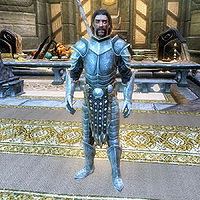| High King Olaf One-Eye | |||
|---|---|---|---|
 High King Olaf One-Eye in Sovngarde High King Olaf One-Eye in Sovngarde
|
|||
| Race | Nord | Gender | Male |
| Died | 1E 452 |
||
| Resided in | Whiterun Sovngarde |
||
| Reign | 1E 420- 1E 452 |
||
| Previous Ruler | Borgas | ||
| Next Ruler | Kjoric the White | ||
| Appears in | Skyrim | ||
King Olaf One-Eye was a First Era Nord Jarl of Whiterun (and later High King of Skyrim) famous for imprisoning the Dragon Numinex within his palace, which was dubbed Dragonsreach in honor of this feat. Olaf purportedly confronted the dragon with some of his troops on top of Mount Anthor, where he used the Thu'um to aid him in a duel which ended in Numinex's defeat. Olaf then conveyed the dragon back to Whiterun where he imprisoned it in his castle. Numinex was purportedly imprisoned there until his death.[1] After death, the dragon's skull was kept as a trophy, and was still on the wall above the throne in Dragonsreach, where it has remained into modern times.[2]
Due to his fame, Olaf was eventually named High King of Skyrim.[1] However, his reign, which started in 1E 420 and lasted 32 years,[3] saw its share of controversy. Notably, the bard Svaknir wrote a scathing verse decrying him as a fraud and a tyrant.[1][4] Olaf responded by imprisoning the bard and destroying every copy of the verse which could be found. Ancient bard texts, perhaps inspired by Svaknir, claimed that Olaf and his men came upon a weakened Numinex and captured the dragon without significant effort, and fabricated the orthodox tale to ensure his place as Jarl and possibly to aid in his bid to become High King.[1] Believers of the non orthodox account would speculate just how exactly Olaf pulled off the feat of imprisoning Numinex, some of the theories were that Olaf came upon Numinex while he was asleep, others that he struck a deal with him, and some theories even went as far as to speculate that Olaf himself was the Dragon Numinex who was able to polymorph between human and dragon forms.[5] An effigy of Olaf is ritually burned in Solitude as part of an annual festival known as "The Burning of King Olaf".[6] However, Olaf is still remembered in Skyrim for reuniting the province after the War of Succession and for conquering The Reach.[3] The story of Olaf's deeds, whether true, exaggerated or false, is known to have inspired at least one subsequent event - the capture, in the same hall of Dragonsreach in Whiterun, of the dragon Odahviing by the Last Dragonborn, with the current Jarl's assistance[7]: showing that even a dragon at the height of its powers could indeed be brought down and captured alive.
In 2E 582 a journal describing how one of Solitude's inhabitants, Ysogar, experienced a strange phenomenon related to King Olaf, after reading the journal of one of his own ancestors, was found. In the journal, Ysogar's ancestor described how, after moving to Solitude, she began to experience strange dreams of the city's past, ranging from it's original construction to Olaf's coronation and burning festival. The ancestor eventually realized that she was somehow travelling to different eras of the past in her sleep when the people in the dream noticed her and reacted to her presence, and concluded that her dreams were being sent by someone since she'd immediately be moved to a different time upon being seen. The original journal culminated in the ancestor being moved to different time periods during the same night, and experiencing nightmares of Olaf's shade glaring as his effigy burned, before waking up with severe burns over most of her own body. Though initially dismissive of his ancestor's account as fabrication, Ysogar would soon begin experiencing strange dreams of Olaf and waking up with parts of his body burning himself, sometime after the charred remnants of his own journal were found by the Vestige.[8]
In 4E 201, in an effort to recover King Olaf's Verse, a lost part of the Poetic Edda, Viarmo the headmaster of the Bards College had the Last Dragonborn plunder Olaf's tomb in Dead Men's Respite to find it, and thus earn membership at the College. The Dragonborn accompanied by the restless spirit of Svaknir the bard fought the draugr that once was the High King of Skyrim, and was able to defeat him which allowed Svaknir's spirit to finally rest.[5] Later that year, the Last Dragonborn upon arriving to Sovngarde encountered both Svaknir and Olaf in the Nordic afterlife. Olaf, while still critical of his works as a bard, had come to respect Svaknir as an honest enemy, who he hoped to welcome as a friend.[9]
GalleryEdit
Olaf's corpse as an undead draugr
See AlsoEdit
- For game-specific information, see the Skyrim NPC article and the creature article.
BooksEdit
- Olaf and the Dragon by Adonato Leotelli — A historian ponders the legend of Olaf One-Eye and Numinex
- King Olaf's Verse — A lost part of the Poetic Edda, sung during the burning of Olaf's effigy in Solitude
ReferencesEdit
- ^ a b c d Olaf and the Dragon — Adonato Leotelli
- ^ Proventus Avenicci's dialogue in Skyrim
- ^ a b The plaque commemorating Olaf outside the Palace of the Kings in Windhelm
- ^ King Olaf's Verse
- ^ a b Tending the Flames faction quest in Skyrim
- ^ Walking the World, Vol XI — Spatior Munius
- ^ The Fallen quest in Skyrim
- ^ Solitude: A Charred Journal — Ysogar
- ^ Dragonslayer quest in Skyrim